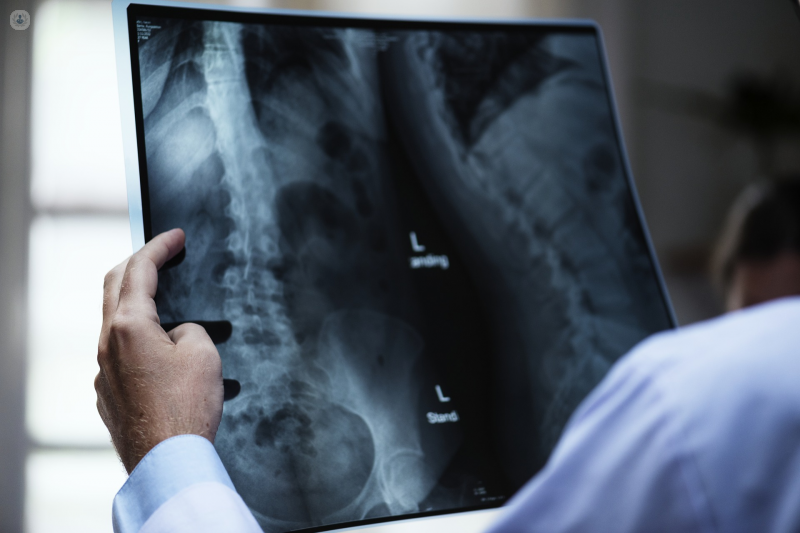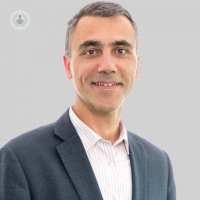Fracture recovery: tips from an expert
Written by:A fracture is the most common injury seen by orthopaedic specialists and can affect any bone in the body and happen at any age. It usually results from an application of great force to any part of the body, exceeding the amount of energy that the bone can absorb. This can happen during physical activities, road traffic accidents or falls. Mr Peter Peev, a consultant orthopaedic surgeon, explains the various types of fractures and gives some tips on how to speed up recovery.

What are the different types of fracture?
Fractures are characterised by the displacement of the bone fragments. When the bony ends are aligned together the fracture is non-displaced. If the bone is angulated or the bony parts are out of place, the fracture is displaced.
Non-displaced fractures can be treated easily with simple splinting as displaced fractures will require the bone to be realigned or reset. Another common description of a fracture defines the number of existing fragments:
- Simple fracture – this usually consists of just two fragments, without damage to surrounding tissues or breaking the skin.
- Comminuted fracture – this is when the bone is shattered or multi-fragmented. Depending on the direction of the fracture line to the bone shaft the fracture can be transverse or oblique.
- Stress fracture - when a fracture results from a repetitive force or overuse it is called a stress fracture.
- Compression fracture - a twisting deformity of a limb will often lead to a spiral fracture. When a bone is crushed by axial loading forces a compression fracture can occur. It results in widening or flattening of the bone. This is commonly seen in vertebral body or heel fractures.
- Greenstick and buckle fractures - there are some unique fracture patterns only seen in children and not in adults. These are greenstick and buckle fractures. The growing bone of a child is more resilient and tends to bend or buckle a lot before it breaks. This is why greenstick fractures are incomplete as only one side of the bone is broken and the opposite side remains intact. With buckle or torus fractures the only sign of bone injury is a small buckling of bone walls, called cortex.
- Compound or open fracture - when there is an open wound or skin break near the fracture site occurs it is called a compound or open fracture. In many cases this wound is caused by a fragment breaking through the skin at the time of the injury. Due to the contamination of the bone and surrounding soft tissues, open fractures carry a risk of infection. This is why prompt cleaning and washing the wound is necessary.
There are some factors that affect the bone quality such as osteoporosis or repetitive injuries. Patients suffering from bone demineralisation often get so called osteoporotic fractures. These can cause the bone to break even during normal activities or simple falls from standing height.
Which is the most serious type of fracture?
Compound fractures are considered among the most serious type of fractures. They often result from high energy injuries and are seen commonly in road traffic accidents. A nerve, vessel or tendon injury can be associated with an open or closed fracture. This indicates the severity of the trauma and can lead to temporary or long term disability.
Very dangerous factures are spine fractures. Fragments can move into the spinal canal and cause compression of the spinal cord. Spinal cord injury is damage to the spinal cord leading to a loss of its function. This could be temporary or permanent. Symptoms are manifested by loss of muscle power, sensation or internal organ function below the level of the injury.
Hip fracture is also a very serious condition causing a lot of pain and inability to mobilise and weight bear. It can lead to permanent damage to the hip joint, which may require hip replacement surgery. In elderly people, hip fractures are associated with increased risk of death. Frail patients may not be able to reach the same functional condition as before the fracture after recovery.
How long does it take for a fracture to heal?
The minimum time it takes a fracture to heal is six to eight weeks. This applies to uncomplicated cases, good bone and general health. With osteoporosis or another medical condition this can take much longer. A broken bone will heal through its natural healing phases:
- The first phase – this is the inflammatory phase, associated with acute swelling, bruising and severe pain. At the fracture site there is haematoma, which attracts the reparative cells.
- The second phase - this is the reparative phase, taking around three weeks. This is the time when the new bone is formed to bridge the broken edges. The new bone is called callus and is immature at this stage.
- The final phase - this is the remodelling phase. During this stage the immature spongy bone is replaced by solid bone. After this, the bone is considered strong enough to sustain normal weight bearing forces.
What tips do you have to help recovery?
To achieve the best functional recovery, it’s important to seek prompt medical advice and follow the recommended treatment. If your fracture is stabilised with surgery you will be allowed to return to physical activities early. Active exercise and movements are the only thing which can prevent stiffness and muscle wasting. When your fracture is treated with a plaster at least one joint will be immobilised for a certain period of time. During this time it is still very important to exercise the joint free of the plaster cast.
If you have a plaster on your wrist it is advisable to exercise your fingers, elbow and shoulder. If your plaster is around your ankle, you have to move your toes, knee and hip. Discuss with your treating surgeon which exercises you are allowed to do.
Maintaining mobility is very important for the limb circulation and preventing blood clots as well.
During the recovery time you have to maintain a healthy diet, which supplies the organs with all macro and micronutrients. If your vitamin D level has been tested as low, then supplementation will be required. People above the age of 50 that have suffered fractures from a simple fall will need to be screened for osteoporosis to decide the best treatment. If you are in this age group the fracture liaison team from your hospital will guide on the screening process.
It is of vital importance to cease smoking if you have been treated for a fracture. Smokers often experience delayed bone healing. This may potentially lead to a condition called non-union where the fracture fails to heal.
People often find themselves with reduced mobility after surgery or following plaster cast treatment. This will require further strengthening exercise to regain power and flexibility.
The extent of the injury, general health condition and compliance to treatment will determine how well and quickly the fracture will heal and varies depending on the individual.
To make an appointment with Mr Peter Peev, visit his profile and book online.


